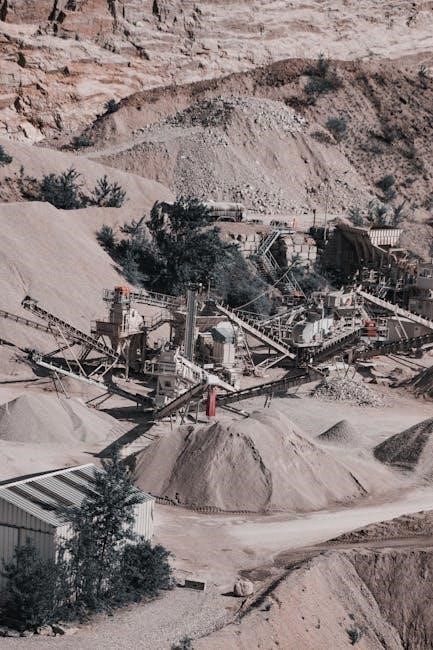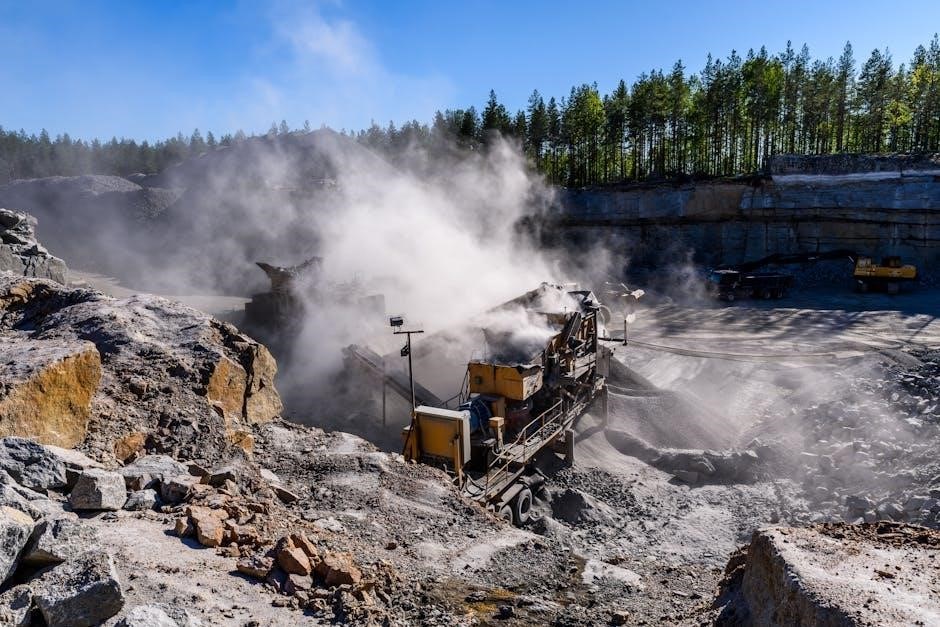Manual rock crushers are essential tools for crushing rock and stone. They are simple, cost-effective, and widely used in prospecting, mining, and construction. They efficiently reduce rock size for various applications.
What is a Manual Rock Crusher?
A manual rock crusher is a handheld or portable device designed to crush rocks, ore, and stone into smaller pieces. It operates through manual force, typically using a lever or crank to apply pressure. These tools are essential for prospecting, mining, and construction, offering a simple and cost-effective way to process materials. Manual crushers are often preferred for their ease of use, efficiency, and ability to handle various types of rock. They are widely used in small-scale operations and laboratories for breaking down samples.
History and Development of Manual Rock Crushers
Manual rock crushers have origins tracing back to ancient civilizations, where people used simple tools like querns and mortars to crush minerals and rocks. Over time, these primitive devices evolved into more sophisticated designs, incorporating levers and gears to enhance efficiency. The development of manual crushers paralleled advancements in mining and construction, with early models made from stone and later from steel. These tools became indispensable for small-scale operations, offering a reliable method for processing materials.
Modern manual rock crushers retain the core principles of their historical counterparts but feature improved designs for better performance and durability. They remain essential for prospecting, laboratories, and small-scale mining, blending tradition with practical innovation to meet contemporary needs.
Importance of Manual Rock Crushers in Modern Applications
Importance of Manual Rock Crushers in Modern Applications
Manual rock crushers remain vital in modern applications due to their simplicity, affordability, and versatility. They are widely used in prospecting, laboratories, and small-scale mining operations for processing ore and rock samples. Their portability and ease of use make them ideal for remote locations and limited budgets. Additionally, manual crushers are essential for crushing rocks in landscaping and construction projects, where precise control and smaller quantities are required. They also serve as eco-friendly alternatives, producing minimal dust and noise. Their enduring relevance underscores their importance in various industries, blending practicality with efficiency for diverse needs.
Types of Manual Rock Crushers
Manual rock crushers include jaw crusher, mortar and pestle, and hand-crank types. Each design offers unique advantages for crushing rock efficiently in various settings and applications.
Jaw Crusher Type Manual Rock Crusher
The jaw crusher type manual rock crusher is a popular choice for small-scale operations. It mimics the action of industrial jaw crushers, using a moving jaw to crush rocks against a stationary one. This design is durable and effective for breaking down tough materials. Users operate it by manually turning a handle to move the jaw, making it a cost-effective option for those needing to process rocks without electric power. Its simplicity and reliability make it a favorite among prospectors and hobbyists. Regular maintenance ensures longevity and optimal performance.
Mortar and Pestle Type Manual Rock Crusher
The mortar and pestle type manual rock crusher is a traditional tool used for crushing rocks and minerals into smaller fragments. Its simple design consists of a sturdy bowl (mortar) and a heavy pestle. This crusher is ideal for small-scale operations, as it allows for precise control over the crushing process. It is commonly used by prospectors and in laboratory settings to prepare rock samples for further analysis. The mortar and pestle crusher is manually operated, requiring users to grind rocks against the bowl’s surface. While it is labor-intensive, it is highly effective for processing small quantities of material with minimal equipment.
Hand-Crank Type Manual Rock Crusher
The hand-crank type manual rock crusher is a portable, efficient tool for crushing small rock samples. It features a manual crank that powers a jaw-like mechanism, reducing rocks into fine fragments. This crusher is ideal for prospectors and small-scale miners, as it allows for precise control over the crushing process. Its compact design makes it easy to transport to remote locations. The hand-crank mechanism ensures consistent and reliable operation, even in areas with limited resources. It is commonly used for processing ores, such as gold-bearing quartz, and preparing samples for further analysis. Its durability and ease of maintenance make it a practical choice for manual rock crushing needs.

How to Build a Manual Rock Crusher
Building a manual rock crusher involves assembling durable materials like steel plates and frames. Use tools like welders and drills to construct the crushing mechanism.
Materials and Tools Needed for Construction
Building a manual rock crusher requires durable materials and basic tools. Steel plates, iron frames, and crushed stone are essential for construction. Tools include drills, welders, and hammers.
- Materials: Steel plates, iron frames, crushed stone, and hard metals for crushing surfaces.
- Tools: Welding equipment, drills, hammers, screwdrivers, and safety gear like gloves and goggles.
These components ensure the crusher’s durability and efficiency in crushing rock and stone effectively. Proper assembly and alignment are crucial for optimal performance.
Step-by-Step Instructions for Assembly
Assemble the crusher by first constructing the frame using steel plates and welding equipment. Attach the crushing surfaces, ensuring proper alignment. Install the handle and hinges securely. Tighten all bolts and screws firmly. Mount the flywheel and connect it to the hand-crank mechanism. Test the crusher with small rocks to ensure smooth operation. Always follow safety guidelines during assembly to avoid accidents. Proper alignment and tight fitting are crucial for efficient crushing performance. Double-check all connections before use to ensure durability and safety.
Safety Tips for Building and Operating

Always wear protective gear, including gloves, goggles, and a dust mask. Ensure the crusher is placed on a stable, level surface. Keep loose clothing and long hair tied back. Avoid operating the crusher near flammable materials. Regularly inspect the device for wear and tear. Lubricate moving parts to prevent overheating. Never leave the crusher unattended while in use. Store the crusher in a dry, secure location when not in use. Follow proper assembly and maintenance procedures to ensure safe operation. Keep children and pets away from the crusher during use.
Applications of Manual Rock Crushers
Manual rock crushers are essential tools for prospecting, mining, and laboratory sampling. They are also used in landscaping and construction for crushing rocks and aggregates.
Rock Crushing for Prospecting and Mining
Manual rock crushers are indispensable in prospecting and mining, facilitating the efficient processing of ore samples. They effectively reduce large rocks into smaller fragments, enabling the extraction of valuable minerals like gold and silver. Their portability is a significant advantage, making them suitable for remote mining sites. Additionally, their reliability ensures consistent performance in harsh environments. These crushers are versatile, capable of handling diverse rock types, and are essential for small-scale operations. By simplifying the crushing process and saving time, they are crucial tools for prospectors and miners, aiding in preliminary assessments and enhancing overall mining efficiency and productivity.
Use in Laboratory Settings
Manual rock crushers are highly valued in laboratory settings for their precision and control in sample preparation. They enable researchers to process small rock or mineral samples with minimal contamination and high accuracy; Their compact design makes them ideal for limited workspace, while their quiet operation reduces noise pollution. Laboratories rely on these crushers for consistent results, as they allow for precise particle size adjustment. The ease of cleaning and maintenance further enhances their suitability for sterile environments. Manual rock crushers are essential tools in geological, metallurgical, and environmental research, ensuring reliable and efficient sample processing for accurate analysis and experimentation.
Crushing Rocks for Landscaping and Construction
Manual rock crushers are invaluable for crushing rocks in landscaping and construction projects. They enable the processing of materials like gravel, stones, and concrete into usable aggregate on-site, reducing transportation costs and time. Their portability and lack of reliance on electricity make them ideal for remote or small-scale projects. Whether creating decorative stone for gardens or producing material for pathways and foundations, manual crushers offer a practical solution. They also allow for the reuse of materials, promoting sustainability. Their ease of use and affordability make them a popular choice for DIY enthusiasts and small contractors aiming to achieve professional-grade results efficiently.
Safety Precautions and Best Practices
Always wear protective gear like goggles, gloves, and a dust mask when operating a manual rock crusher. Ensure proper setup and maintain a safe distance during operation. Regular lubrication and inspections are crucial for preventing accidents. Never insert hands or tools while the crusher is in motion. Follow manufacturer guidelines strictly to ensure safe and efficient crushing processes. Proper training and adherence to safety protocols significantly reduce the risk of injury or equipment damage.
Wearing Protective Gear
Wearing proper protective gear is essential when operating a manual rock crusher. This includes safety glasses or goggles to protect eyes from flying debris, a dust mask to prevent inhalation of fine particles, and sturdy gloves to prevent hand injuries. Steel-toe boots or robust footwear can safeguard feet from heavy objects. Hearing protection, such as earplugs, may also be necessary to shield against loud noises. Properly fitted gear ensures optimal protection and comfort. Always inspect gear for wear and tear before use and follow manufacturer guidelines to enhance safety during crushing operations. This practice minimizes risks and ensures a safer working environment.
Operating the Crusher Safely
Operating a manual rock crusher requires careful attention to safety protocols. Always ensure the crusher is placed on a stable, level surface and securely anchored to prevent movement during use. Follow the manufacturer’s instructions for proper operation and load capacity. Avoid overloading the crusher, as this can lead to mechanical failure or accidents. Keep hands and fingers away from moving parts, and never attempt to crush materials that are too hard or oversized. Regularly inspect the crusher for damage or wear and ensure all components are functioning correctly before use. Maintain a safe distance from bystanders and ensure proper ventilation in the workspace.
Regular Maintenance for Safe Operation
Regular maintenance is essential for ensuring the safe and efficient operation of a manual rock crusher. Lubricate moving parts periodically to reduce friction and wear. Inspect the crusher’s components, such as the jaw plates and toggles, for signs of wear or damage, and replace them as needed. Clean the crusher regularly to remove dust and debris that could interfere with its function. Check the alignment of moving parts and tighten any loose bolts or fasteners. Proper maintenance not only extends the lifespan of the crusher but also prevents accidents caused by mechanical failure. Keep a maintenance log to track upkeep activities.

Maintenance and Repair of Manual Rock Crushers
Regular maintenance ensures optimal performance and longevity of manual rock crushers. Inspect for wear, lubricate moving parts, and address issues promptly to prevent breakdowns and ensure safe operation.
Importance of Regular Lubrication
Regular lubrication is essential for manual rock crushers to reduce friction and wear on moving parts. Proper greasing ensures smooth operation and prevents overheating, which can damage components. Use high-quality, heavy-duty lubricants suitable for rugged applications. Apply lubricant to pivot points, hinges, and crushing surfaces regularly, as specified in the manufacturer’s guidelines. Neglecting lubrication can lead to premature wear, increased maintenance costs, and potential equipment failure. Consistent lubrication extends the lifespan of the crusher and maintains its efficiency in processing rocks effectively. Always clean surfaces before applying lubricant to avoid contamination and ensure optimal performance.
Replacing Worn-Out Parts
Replacing worn-out parts is crucial for maintaining the efficiency and longevity of manual rock crushers. Regularly inspect components like crushing plates, hinges, and gears for signs of wear. Replace damaged or excessively worn parts immediately to prevent further damage. Use original equipment manufacturer (OEM) parts or high-quality alternatives to ensure compatibility. Keep a stock of common wear parts to minimize downtime. Timely replacements reduce the risk of equipment failure and maintain optimal performance. Always follow manufacturer guidelines for part replacement to ensure safety and operational effectiveness. Proper replacement practices help extend the crusher’s lifespan and reliability. Consistency is key to avoiding costly repairs.
Storage and Transportation Tips
Proper storage and transportation of manual rock crushers are essential to maintain their functionality and longevity. Store the crusher in a dry, secure location to protect it from environmental damage. When transporting, ensure the crusher is securely fastened to prevent movement and potential damage. Use protective coverings to shield against dust and moisture during transit. For long-term storage, apply rust-inhibiting coatings and drain any fuel from the device. Always follow local transportation regulations and handle the equipment with care to avoid accidents. Regularly inspect the crusher before and after transportation to ensure it remains in good working condition.

Environmental Impact of Manual Rock Crushers
Manual rock crushers can generate dust emissions and noise pollution, impacting air quality and nearby ecosystems. Sustainable practices and proper usage are essential to minimize environmental disruption.

Dust Emission and Control Measures
Manual rock crushers produce dust during operation, potentially harming air quality and health. To mitigate this, water sprinklers can be used to moisten materials before crushing. Covering the crusher and using vacuum systems help contain dust. Regular cleaning and proper ventilation in work areas reduce exposure. Operators should wear masks to minimize inhalation risks. Implementing these measures ensures safer, eco-friendly rock crushing processes.

Noise Pollution Considerations
Manual rock crushers can generate significant noise during operation, potentially causing disturbances. The mechanical action and impact of crushing rocks produce sound levels that may exceed safe thresholds. Prolonged exposure can lead to hearing damage for operators. To minimize noise pollution, crushers should be operated in well-ventilated, open areas away from residential zones. Using sound-dampening materials or barriers can reduce noise levels. Regular maintenance, such as lubricating moving parts and ensuring proper alignment, also helps reduce operational noise. These measures are essential for safe and environmentally responsible rock crushing activities.
Eco-Friendly Alternatives and Practices
Manual rock crushers can be adapted for eco-friendly use by incorporating sustainable practices. Using recycled materials for construction reduces environmental impact. Operators can opt for manual or pedal-powered crushers to eliminate fossil fuel reliance. Solar-powered models offer a greener alternative for small-scale operations. Eco-friendly lubricants and biodegradable components further minimize harm. Additionally, crushed rocks can be repurposed for landscaping or construction, reducing waste. Promoting responsible sourcing of materials and encouraging community recycling programs also aligns with environmental goals. These practices ensure manual rock crushers remain a viable, eco-conscious tool for various applications.

Cost-Effectiveness of Manual Rock Crushers
Manual rock crushers are an affordable, low-maintenance option for small-scale operations, offering significant cost savings on energy and labor. Their portability and durability ensure long-term efficiency.
Budget-Friendly Option for Small-Scale Operations
Manual rock crushers are a cost-effective solution for small-scale operations, offering a low initial investment and minimal operating costs. They are ideal for individuals, hobbyists, and small businesses, as they require no electricity, reducing energy expenses. Their lightweight and portable design allows for easy transportation to remote sites, making them perfect for limited-space projects. With simple maintenance and durable construction, manual crushers provide reliable performance without the need for expensive repairs. This makes them an excellent choice for those seeking an affordable yet efficient tool for rock crushing, ensuring productivity while staying within budget constraints.
Long-Term Savings on Maintenance
Manual rock crushers offer significant long-term savings on maintenance due to their simple, durable design. With fewer moving parts compared to automated crushers, there’s less wear and tear, reducing repair costs. Regular lubrication and occasional part replacements are often the only upkeep needed. This minimal maintenance requirement ensures consistent performance over time without hefty expenses. Additionally, the absence of complex hydraulic systems or electrical components lowers the risk of costly breakdowns. Overall, manual rock crushers provide a reliable, low-maintenance solution, making them a practical choice for budget-conscious users seeking sustained efficiency and reduced long-term operational costs.
Initial Investment and Return
Manual rock crushers typically require a lower initial investment compared to automated or electric models. Their straightforward design reduces production costs, making them more accessible for small-scale operations or hobbyists. While the initial purchase price may seem modest, the long-term return on investment is substantial. Manual crushers often outlast more complex machines due to their simplicity, providing years of reliable service. For small businesses or individuals, the cost-effectiveness of manual rock crushers ensures a steady return through efficient rock processing without the financial burden of high-tech machinery, making them a smart choice for budget-conscious users seeking durability and value.
Troubleshooting Common Issues
Manual rock crushers may face issues like jamming or wear, but identifying and addressing these problems promptly ensures optimal performance and extends equipment lifespan.

Dealing with Jamming and Blockages
Dealing with jamming and blockages in manual rock crushers requires immediate attention to prevent damage. Start by stopping the crusher and ensuring safety. Use tools like wrenches or pry bars to carefully remove obstructing material. Regularly inspecting and maintaining the crusher can help prevent jams. Ensure materials are appropriately sized and aligned before crushing. Wearing protective gear is essential when addressing blockages. Frequent jams may indicate the need for adjustment or repair. Always follow manufacturer guidelines to avoid further issues.
Addressing Wear and Tear
Addressing wear and tear in manual rock crushers is crucial for maintaining efficiency and longevity. Regularly inspect moving parts, such as hinges and crushing surfaces, for signs of damage. Lubricate pivot points to reduce friction and prevent premature wear. Replace worn components, like jaw plates or pestle tips, with durable materials. Check alignment to ensure even stress distribution. Tighten loose fasteners to avoid further damage. Schedule routine maintenance to address minor issues before they escalate. Replacing parts promptly can prevent costly repairs and downtime, ensuring optimal performance for years.
Improving Crushing Efficiency

Improving the efficiency of a manual rock crusher involves optimizing its operation and maintenance. Ensure rocks are fed at the correct size for the crusher’s capacity. Adjust the crushing angle and apply consistent pressure to maximize output. Keep the jaw plates or grinding surfaces sharp, as dull edges reduce effectiveness. Regularly clean the crusher to remove dust and debris, which can hinder performance. Proper alignment of moving parts ensures even force distribution. By minimizing unnecessary friction and maintaining precise settings, you can achieve higher throughput with less effort, making the crusher more efficient for small-scale operations.




